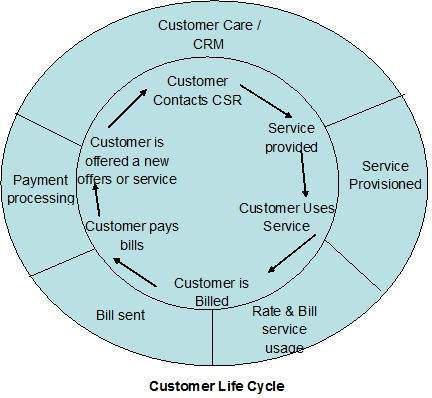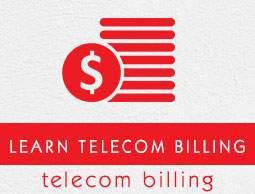Telecom Billing - Customer Acquisition
A customer is a "legal entity" (that can be either an individual or a company) that takes the products and services offered by the service provider and responsible for paying the bills. In a residential billing scenario, a customer might be a single householder. In a business billing scenario, a customer might be a corporation.
Individual customer − An individual customer is a single person (or household), who buys one or more products and pay the bills. There would not be any hierarchy required to maintain customer or account.
Company customers − A company customer is a single company or branch of a company. There could be a typical parent and child type of customer hierarchy representing different branches or departments of the company.
Customer Acquisition Process
Customer Acquisition is the process of identifying, attracting and retaining the potentially profitable customers. This is a handled using system called Customer Relationship Management (CRM), which is one of the important business support systems (BSS).
A CRM system would always be connected with various systems including billing system and feeds customer personal data and product and service information to the billing system.
A customer, who is purchasing the products & services, needs to be activated in the system and for this, various details about the customer are required −
The customer may have to fill up an application form providing personal details.
Validate the identity of the customer in order to prevent fraud.
Service Provider needs to carry out a credit check on the customer and assign appropriate credit class based on credit history and monthly income, etc.
Offer appropriate products, which are provisioned at the network to provide the service.
Once the customer is acquired, it is required to manage and retain the customer, which involves −
Interacting & communicating with the customer for sales and collection activities.
These interactions can be recorded in different formats like Notes, voice recordings, etc. This data can be used to analyze the behavior of the customer and helps the service provider to provide better services in order to retain the customer
Handling trouble tickets raised by the customers against any problem they face with the network or invoice, etc. This data can also be used to analyze the behavior of the customer and helps the service provider for the betterment of the services in order to retain the customer.
Handling any bill disputes and adjustments raised in between the customer and service provider.
Customer Life Cycle
A typical customer life cycle is shown below in the following diagram −

All the phases comprising a customer life cycle are briefed here −
Customer Engagement − The customer contacts the CSR (Customer Service Representative) and the CSR engages the customer with the various products and services offered by selling them to the customer.
Order Creation and Fulfilment − The customer takes the product(s) and services(s) and the CSR creates and completes the order into the system, which is then fulfilled by supplying required product and services to the customer.
Service Provisioning − The products and services are provisioned at the network using a system called Provisioning System. The Provisioning System informs the network about the customer's information and the services they are authorized to use. In fact, this activates the customer on the network.
Products Utilization − Once the customer is activated on the network, the customer starts using the products & services including, making a call, data download, etc.
Products and services usage is Rated & Billed − Customer usage is collected from the network and then it is rated based on the defined rate plans and billed to apply product rentals and required discounts, adjustments, etc.
Bill Delivery − Once a bill is generated, it is delivered to the end customer demanding for the revenue against the services provided.
Bill Payments − Customer makes the payments against the received invoices.
Dunning & Collection − There may be many customers, who will not pay their bills on time. For such type of customers, different dunning letters are sent to remind them about their payments. If a customer does not pay on time, then different collections are taken starting from stopping the customer services one by one.
Customer Termination − There may be various reasons when it is required to terminate a customer in the system. For example, customer may be migrating to different location, or customer may not be happy with the services provided, etc.
On a given date, total number of active customers in the system are called the customer base. Adding a customer into the system, and terminating a customer from the system, is known as customer churn.
Customer Types
Typically, there are following types of customers in today's telecom market −
Mobile Pre-Paid Customers − These are the customers, who use Mobile services by paying their charges in advance. For example, GSM, GPRS phone users. These customers recharge their phone based on their requirements.
Mobile Post-Paid Customers − These are the customers, who use Mobile services by paying their charges after every invoice they receive. For example, GSM, GPRS phone users. These customers pay their bills on monthly or bi-monthly basis.
Fixed Pre-Paid Customers − These are the customers, who use Fixed line, i.e., landline services by paying their charges in advance. For example, PSTN, WiMax phone users. These customers recharge their phones based on their requirements.
Fixed Post-Paid Customers − These are the customers, who use Fixed line, i.e., landline services by paying their charges after every invoice they receive. For example, PSTN, WiMax phone users. These customers pay their bills on monthly or bi-monthly basis.
What is next?
Now, we have customers in our billing system along with products and services. Customer starts utilizing all the products and services bought and start generating national and international, data and voice calls, which will be rated and billed by the billing system and we will discuss those processes in subsequent chapters.



